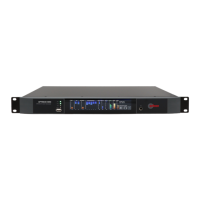2-4 Installation
If a separate stereo encoder must be used, feed the encoder directly from the 5950’s left and right analog outputs.
If possible, bypass the pre-emphasis network and the input low-pass filters in the encoder so that they cannot
introduce spurious peaks.
Because of their special design, THE OPTIMOD-5950’s pre-emphasis network and low-pass filters perform the
same functions while retaining tight peak control. Connect the composite output of the 5950 to the baseband
input of the exciter through less than 100 feet (30 meters) of coaxial cable.
100 feet of coaxial cable (assuming 30-pF / foot capacitance) will reduce measured separation at 15 kHz (worst
case) to approximately 60dB. This separation is comfortably above the separation (approximately 20dB) that starts
to cause perceptible changes in the stereo image.
Studio-Transmitter Link
Transmission from Studio to Transmitter: There are five types of studio-transmitter links (STLs) in common use in
broadcast service: uncompressed digital, digital with lossy compression (like MPEG, Dolby®, or APT-x®),
microwave, analog landline (telephone / post line), and audio subcarrier on a video microwave STL.
STLs are used in three fundamentally different ways. They can either:
1) Pass unprocessed audio for application to the 5950’s input.
2) Pass the 5950’s peak controlled analog or digital left and right audio outputs.
3) Pass the 5950’s peak-controlled composite stereo baseband output.
The three applications have different performance requirements. In general, a link that passes unprocessed audio
should have very low noise and low nonlinear distortion, but its transient response is not important. A link that
passes processed audio doesn’t need as low a noise floor as a link passing unprocessed audio. However, its
transient response is critical. At the current state of the art, an uncompressed digital link using digital inputs and
outputs to pass audio in left/right format achieves best results. We will elaborate below.
Digital Links: Digital links may pass audio as straightforward PCM encoding or they may apply lossy data reduction
processing to the signal to reduce the number of bits per second required for transmission through the digital link.
Lossy data rate reduction will almost invariably distort peak levels and such links must therefore be carefully
qualified before you use them to carry the peak-controlled output of the 5950 to the transmitter. For example, the
MPEG Layer 2 algorithm can increase peak levels up to 4 dB at 160kB / sec by adding large amounts of quantization
noise to the signal. While the desired program material may psychoacoustically mask this noise, it is nevertheless
large enough to affect peak levels severely. For any lossy compression system the higher the data rate, the less the
peak levels will be corrupted by added noise, so use the highest data rate practical in your system.
It is practical (though not ideal) to use lossy data reduction to pass unprocessed audio to the 5950’s input. The
data rate should be at least of “contribution quality”— the higher, the better. If any part of the studio chain is
analog, we recommend using at least 20-bit A/D conversion before encoding.
Because the 5950 uses multiband limiting, it can dynamically change the frequency response of the channel. This
can violate the psychoacoustic masking assumptions made in designing the lossy data reduction algorithm.
Therefore, you need to leave “headroom” in the algorithm so that the 5950’s multiband processing will not

